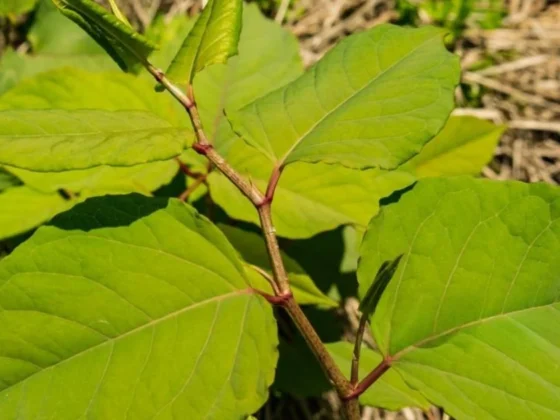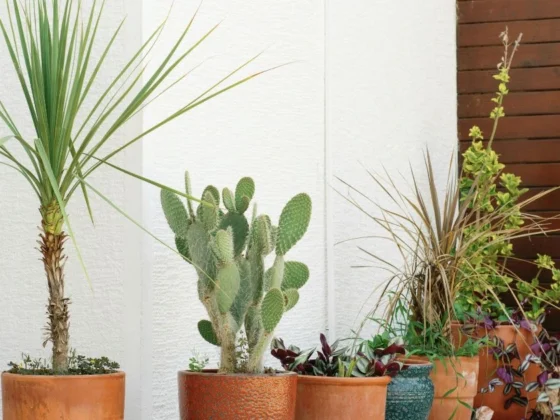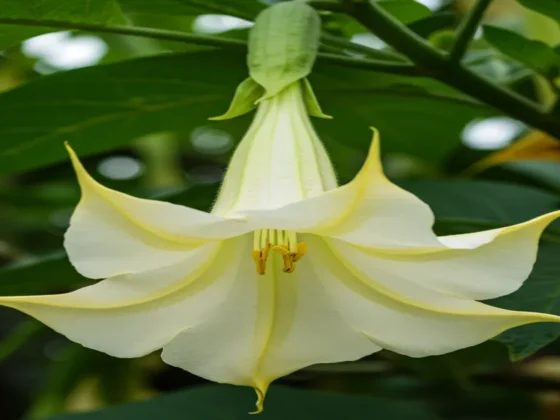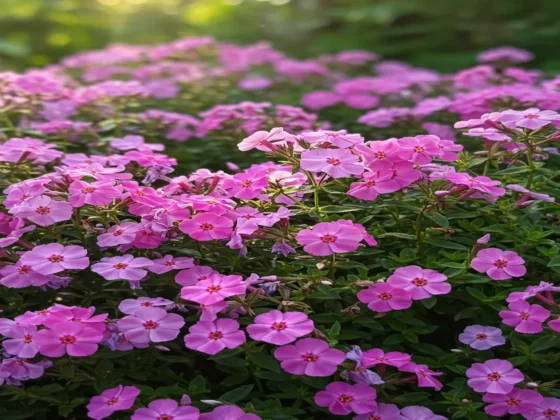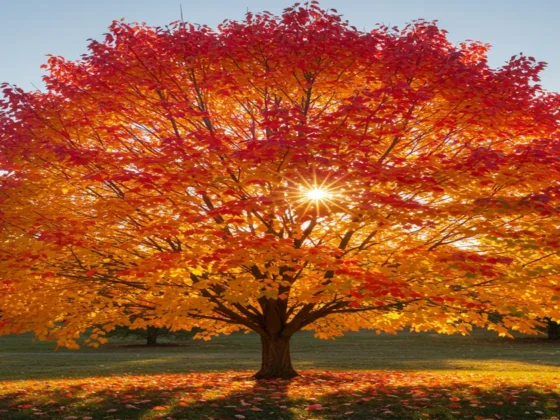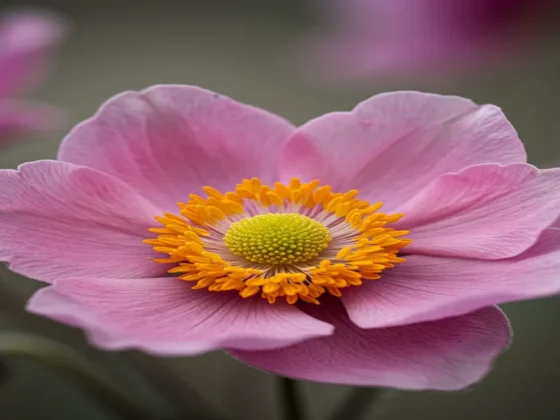Spring gardens come alive with colors, and the daffodil flower is a standout. These bright blooms mark the end of winter, bringing warmth to the UK. Whether you love gardening or just enjoy plants, learning about daffodils can change your outdoor space.
Daffodil flowers are more than pretty plants. They symbolize strength, hope, and spring’s fresh start. With their rich history and many varieties, they let gardeners create beautiful displays that show nature’s beauty.
Why Are Daffodils the Perfect Flower for Spring ?
The daffodil flower is a beloved sign of spring. It brings joy to gardeners and nature lovers with its bright colors and long history. These flowers have been loved for centuries, adding life and beauty to gardens everywhere.
What Are the Different Types of Daffodils ?
Daffodils are part of the Narcissus genus. They are divided into 13 types based on their special features. Each type shows the amazing variety of these spring flowers.
- Trumpet Daffodils: Known for their large, trumpet-shaped centers
- Double Daffodils: With layers of petals
- Split-Corona Daffodils: Have split or multi-colored centers
Historical Significance of Daffodils
Daffodils have a long history, dating back thousands of years. They originated in the Mediterranean. Greek myths and archaeological finds show they were grown in ancient times.
| Historical Period | Daffodil Significance |
|---|---|
| Ancient Greece | Linked to narcissus myths |
| Victorian Era | Stood for renewal and hope |
| Modern Times | Used for cancer research fundraising |
Cultural Symbolism and Meaning
When do daffodils bloom? They bloom in early spring, holding deep cultural meanings. In Wales, the daffodil is the national flower, symbolizing hope and strength.
“A daffodil is a perfect example of nature’s ability to bring joy and renewal,” says botanical historian Dr. Elizabeth Roberts.
Daffodils represent new beginnings and rebirth. They inspire and delight gardeners and flower lovers all over the world.
When Do Daffodils Bloom : Seasonal Growth Guide
Learning about daffodils’ blooming cycle can make your garden pop in spring. Daffodils usually bloom in early spring. The exact time varies based on a few important factors.
When do daffodils bloom? Most types start showing off their yellow and white colors between late February and early April. The timing depends on:
- Geographic location and climate zone
- Planting depth of bulbs
- Local weather conditions
- Specific daffodil variety
Choosing the right Daffodil Flower varieties can make your garden bloom longer. Early-blooming varieties show up in late winter. Late-blooming types keep going well into mid-spring.
“The secret to a prolonged daffodil display is selecting multiple varieties with staggered blooming periods.” – Royal Horticultural Society
Your local weather greatly affects when daffodils bloom. In warmer places, they bloom sooner. In colder areas, they bloom later. Planting bulbs correctly and giving them enough winter chill helps a lot.
By knowing these details, you can make your garden a beautiful daffodil showcase. It will add color and happiness to your spring garden.
Planting Daffodil Bulbs the Right Way
Planting daffodil bulbs is a fun way to add color to your garden in spring. It needs careful planning and attention. This guide will help you grow daffodil bulbs with confidence.
To get stunning daffodils, you need to know how to plant them right. With a few simple steps, you can make your garden beautiful.
Best Time for Planting
When to plant daffodil bulbs is very important. The best time is from late September to early November. This lets the bulbs grow strong roots before winter.
- Plant 4-6 weeks before ground freezes
- Choose cool autumn days for optimal results
- Avoid planting during extreme temperature fluctuations
Soil Preparation Methods
Soil is key for growing daffodil bulbs well. You need soil that drains well and is rich in nutrients. This helps your daffodils grow healthy.
| Soil Characteristic | Recommended Condition |
|---|---|
| pH Level | 6.0-7.0 (Slightly Acidic to Neutral) |
| Organic Matter | Add compost or well-rotted manure |
| Drainage | Ensure excellent water drainage |
Bulb Spacing Guidelines
Spacing is important for healthy growth and beautiful blooms. Here are some tips Daffodil Flower for spacing:
- Plant bulbs 4-6 inches deep
- Space bulbs 4-6 inches apart
- Create clusters for dramatic visual impact
“The beauty of daffodils lies not just in their blooms, but in the careful preparation that precedes them.” – Garden Experts
By following these Daffodil Flower tips, you’ll have a stunning garden in spring. It will celebrate nature’s renewal.
Choosing the Perfect Location for Your Daffodil Flower
Finding the right spot for your daffodil flower is key for bright blooms and strong growth. The place you pick can greatly affect your daffodil bulbs’ health all season.
When growing daffodil bulbs, keep these location tips in mind:
- Sunlight exposure: Daffodil Flower do best in full sun to partial shade
- Soil drainage: Places with good drainage stop bulb rot
- Wind protection: Safe spots keep delicate blooms intact
- Temperature considerations: Stay away from frosty areas
Your garden’s microclimate is vital for daffodil success. Look for areas that offer:
- Morning sunlight
- Shade from strong afternoon sun
- Good air flow
“The right location transforms daffodil bulbs from mere plants into stunning garden showstoppers.” – Garden Expert
Some great places to plant include: • Woodland edges • Rock gardens • Borders near shrubs • Naturalized meadow areas
Daffodil flowers fit well in many garden spots. Your creativity in where you plant them can lead to amazing spring views every year.
Daffodils in Pots: Container Growing Tips
Growing daffodils in pots is great for those with little space or who want to brighten up areas. Potted daffodils are flexible and add beauty. To grow them well, you need to know a few key tips.
Selecting the Perfect Container
When picking containers for daffodils, keep these points in mind:
- Make sure pots have holes for drainage
- Choose pots that are 6-8 inches deep
- Terracotta and ceramic pots are good for keeping moisture right
- Pots should be wide enough for more than one bulb
Indoor and Outdoor Container Care
Daffodils in pots need different care based on where they are. Indoor pots should stay between 50-60°F. Outdoor pots need protection from harsh winter weather.
“The secret to successful container daffodils is understanding their environmental needs,” says horticultural expert Sarah Thompson.
Repotting Guidelines
To keep daffodil bulbs healthy, follow these repotting tips:
- Replant bulbs every 3-4 years
- Divide clusters when they get too crowded
- Use fresh, well-draining potting mix
- Remove and store bulbs in a cool, dry place during summer
Pro tip: Always handle daffodil bulbs gently to prevent damage during transplanting.
Water and Fertilizer Requirements
To grow healthy daffodil bulbs, you need to know how to water and feed them. Understanding their water and fertilizer needs is key. This will help you get vibrant, stunning blooms all season.
Watering Essentials
Daffodils love consistent moisture but hate wet soil. Here are some important watering tips:
- Water deeply but infrequently
- Provide about 1 inch of water per week
- Lessen watering after they bloom to avoid rot
Fertilization Strategies
Good nutrition is vital for daffodils to grow strong. Choose a balanced fertilizer that helps bulbs grow and flowers bloom.
| Growth Stage | Fertilizer Type | Application Frequency |
|---|---|---|
| Planting | Bone meal or bulb-specific fertilizer | Once at planting |
| Early Spring | Low-nitrogen, high-potassium fertilizer | When shoots emerge |
| Post-Blooming | Balanced 5-5-5 organic fertilizer | Once after flowering |
“The secret to beautiful daffodils lies in understanding their unique nutritional needs.” – Professional Gardener
Good drainage is crucial for Daffodil Flower health. Make sure your soil drains well to prevent diseases and support strong roots. Avoid overwatering, which can be more damaging than occasional drought.
Common Daffodil Varieties and Their Characteristics
Daffodil flowers add beauty to spring gardens. Each type has its own charm, making choosing them fun and rewarding.
Knowing the different daffodil types helps create a lively garden. They bloom at slightly different times, extending your garden’s colorful season.
Trumpet Daffodils
Trumpet daffodils are the classic, most recognizable type. They have:
- Large, trumpet-shaped central cups
- Typical height of 12-16 inches
- Colors ranging from bright yellow to pristine white
- Early to mid-spring blooming period
Double-Flowered Types
Double-flowered daffodils add drama with their luxurious blooms. They have:
- Ruffled, peony-like flower structures
- Multiple layers of petals
- Soft pastel and vibrant color combinations
- Mid-spring flowering window
Miniature Varieties
Miniature daffodils are perfect for small gardens and containers. They typically:
- Grow 4-6 inches tall
- Produce smaller, delicate blooms
- Thrive in compact spaces
- Bloom in early to mid-spring
Exploring these daffodil varieties lets you create a stunning spring garden. It showcases the beauty and wonder of these flowers.
Preventing and Treating Common Daffodil Problems
Growing daffodil flowers can be tough when unexpected issues pop up. Gardeners must keep a close eye to protect their spring blooms. Knowing how to grow daffodil bulbs means spotting and fixing common problems early.
Some big challenges for daffodil flowers include:
- Fungal infections that can harm bulb health
- Pest invasions that threaten plant health
- Nutrient deficiencies that affect growth
- Environmental stress factors
Prevention starts with the right planting techniques. When learning to grow daffodil bulbs, focus on these key strategies:
- Ensure excellent soil drainage
- Use clean, disease-free bulbs
- Maintain proper spacing between plants
- Practice crop rotation in garden beds
“Healthy daffodils begin with preventative care and keen observation.” – Garden Experts
Diseases like basal rot and narcissus fly can ruin your daffodil collection. Look out for signs like yellow leaves, stunted growth, or unusual spots. Quick action with fungicides or removing infected plants can save your garden.
Nutrient management is key to Daffodil Flower health. Use balanced, low-nitrogen fertilizers for strong bulb growth and to prevent weak growth. Regular soil testing helps you understand and fix nutritional gaps.
Propagation and Division Methods
Expanding your Daffodil Flower garden is exciting. It’s a great way to grow more beautiful flowers. Planting daffodil bulbs through division keeps plants healthy and encourages new growth.
Natural Bulb Division Process
To start, learn how to grow daffodil bulbs naturally. This means separating mature bulb clusters. It helps with growth and prevents overcrowding.
- Identify mature daffodil clumps after flowering
- Wait until foliage has yellowed and died back naturally
- Gently dig around the clump with a garden fork
- Lift the entire cluster carefully from the soil
Optimal Timing for Division
Experts say divide daffodil bulbs every 3-5 years. Late summer to early fall is the best time. It lets bulbs grow roots before winter.
| Timing | Recommended Action |
|---|---|
| Late Summer | Begin inspecting daffodil clumps |
| Early Fall | Dig and divide bulb clusters |
| Late Fall | Replant divided bulbs |
Replanting Techniques
When replanting, make sure to space and prepare the soil right. Plant bulbs 4-6 inches deep, with the pointed end up. Space them 4-5 inches apart for growth room.
“Proper division transforms a single daffodil clump into a vibrant garden display” – Garden Experts
Learning these techniques will help you grow a healthy Daffodil Flower collection. It will bring beauty to your garden every spring.
Companion Planting with Daffodils
Creating a vibrant garden landscape is more than just planting daffodil bulbs. Companion planting can turn your spring garden into a stunning visual masterpiece. It also promotes healthy plant growth.
When planning your daffodil flower garden, consider these strategic companion planting techniques:
- Pair daffodils with early-blooming perennials like forget-me-nots and primroses
- Plant low-growing groundcovers to disguise fading daffodil foliage
- Select plants that share similar sunlight and soil requirements
Ideal companion plants for your daffodil flower garden include:
| Plant Type | Complementary Benefits |
|---|---|
| Tulips | Synchronized blooming, similar growing conditions |
| Hyacinths | Color coordination, pest resistance |
| Muscari | Contrasting height, blue color accent |
When planting daffodil bulbs, remember that strategic companion planting can help deter pests. It creates a more resilient garden ecosystem. Choose plants that provide mutual benefits and enhance each other’s growth potential.
“In nature, no plant grows alone, and your garden should reflect this interconnected harmony.” – Garden Design Wisdom
Post-Blooming Care and Maintenance
After your daffodil flower has finished blooming, it’s important to take good care of it. This ensures vibrant displays in future seasons. Knowing how to grow daffodil bulbs after they’ve bloomed is key to their long-term health.
The most important step is to let the foliage die back naturally. This process helps the bulb store energy for next year’s growth. Don’t cut back the green leaves too soon.
- Leave foliage intact for at least 6-8 weeks after flowering
- Allow leaves to turn yellow and wither naturally
- Avoid braiding or tying daffodil leaves
Removing spent blooms helps the plant focus its energy. Just cut off the flower head, leaving the green stem and leaves. This stops seed production and helps the bulb stay nourished.
| Post-Blooming Care Task | Recommended Action |
|---|---|
| Fertilization | Apply balanced bulb fertilizer after flowering |
| Watering | Reduce water as foliage begins to yellow |
| Foliage Management | Let leaves die back naturally before removing |
For daffodils in lawns, wait until the leaves have died before mowing. Being patient during this time ensures your bulbs have enough energy for next year’s display.
“The secret to beautiful daffodils lies in understanding their post-blooming needs.” – Royal Horticultural Society
By following these care tips, you’ll keep your daffodil bulbs healthy. They’ll continue to brighten your garden for many years.
FAQ
When is the best time to plant daffodil bulbs ?
Plant daffodil bulbs in the fall, from September to November. This is 6 weeks before the ground freezes. It lets the bulbs grow strong roots before winter, ensuring they bloom beautifully in spring.
How deep should I plant daffodil bulbs ?
Plant daffodil bulbs 6 to 8 inches deep, with the pointed end up. In sandy soil, plant them a bit deeper. In clay soil, plant them about 5 inches deep to avoid rot.
Do daffodils come back every year ?
Yes, Daffodil Flower are perennial bulbs that come back every year. They are easy to care for. Let the foliage die back naturally after blooming to help the bulb grow for next year.
Can I grow daffodils in containers ?
Yes! Daffodils do well in pots and containers. Use a pot with good drainage and a well-draining bulb compost. Make sure the pot is deep enough for the bulbs. You can create beautiful displays on patios, balconies, or indoors.
How often should I water daffodil bulbs ?
Water daffodil bulbs well when planting and during spring growth. Once they’re established, they can handle some drought. Avoid too much water in summer to prevent rot.
What companion plants work well with daffodils ?
Tulips, hyacinths, forget-me-nots, and early-blooming ground covers like pachysandra are good companions. They hide fading daffodil foliage and add interest to your garden in spring.
How do I prevent wildlife from eating my daffodil bulbs ?
Daffodil Flower are toxic to most wildlife, like rodents, deer, and rabbits. Plant them in areas where wildlife is common. Their toxicity makes them a great choice for gardens with animals.
When do daffodils typically bloom ?
Daffodils bloom in early to mid-spring, depending on your area and variety. Most bloom between March and April. Some varieties bloom as early as late February, while others bloom into May.
How long do daffodil flowers last ?
Daffodil flowers last about 7 to 10 days, depending on the variety and weather. A daffodil plant blooms for 2 to 3 weeks, adding color to your garden in spring.
Can I divide my daffodil bulbs ?
Yes, divide daffodil bulbs every 3 to 5 years. Do this after the foliage dies back naturally, in late spring or early summer. Dig up the clumps, separate the bulbs, and replant them right away for healthy growth.



